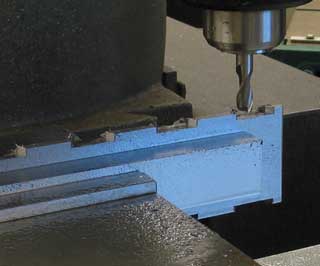
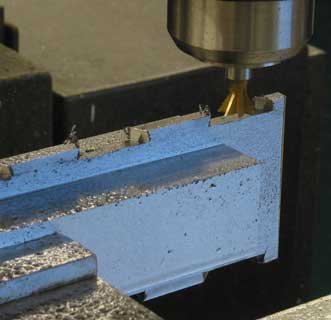
These milling maching programs use the CNC language of the Anilam 1100 three-axis control. Its "conversational" program files have a .m extension. The mapping from this language to G-codes is generally obvious, so a translation to G-codes should be easy, if that's what you need.
I caution those who would use these programs to review all aspects of the machining before proceeding. CNC programs such as these cannot take into account all aspects of making a part. Important variables include fixturing the part to clear all tool paths, and cutting speeds and feeds. I tried to set the feed rates so that running at 100% won't burn anything up. (This control has a 0-120% feedrate knob which can be adjusted during the run, and I'm constantly fiddling with it.) In any case, it's wise to make test runs with the Z axis set high enough to clear everything, then test parts in wood, especially of the dovetails for fit-testing. You will note that I needed to tighten up the dovetails by five or six thousandths before cutting the parts.
| Part | Portion | CNC program | Tool |
|---|---|---|---|
| Sole | left edge pins | psole-l1.m (HTML or text) |
3/8" end mill |
| Sole | left edge pins | psole-l2.m (HTML or text) |
1/2" 60° dovetail † |
| Sole | right edge pins | psole-r1.m (HTML or text) |
3/8" end mill |
| Sole | right edge pins | psole-r2.m (HTML or text) |
1/2" 60° dovetail † |
| Each Side | bottom (dovetails) | psidedn1.m (HTML or text) |
1/2" end mill |
| Each Side | bottom (dovetails) | psidedn2.m (HTML or text) |
1/2" 60° dovetail † |
| Each Side (optional) |
bottom (unpeened portion removal) | psidedn3.m (HTML or text) |
1/2" end mill |
| psidedn4.m (HTML or text) |
3/8" to 3/4" 45° chamfer mill | ||
| Left side | top profile or chamfer, rear | PLSIDUP1.M (HTML or text) |
1/2" end mill or 3/4" 45° chamfer mill ‡ |
| top profile, mid | PLSIDUP2.M (HTML or text) |
1/2" end mill | |
| top profile or chamfer, front | PLSIDUP3.M (HTML or text) |
1/2" end mill or 3/4" 45° chamfer mill † |
|
| Right side | top profile or chamfer, rear | PRSIDUP1.M (HTML or text) |
1/2" end mill or 3/4" 45° chamfer mill ‡ |
| top profile, mid | PRSIDUP2.M (HTML or text) |
1/2" end mill | |
| top profile or chamfer, front | PRSIDUP3.M (HTML or text) |
1/2" end mill or 3/4" 45° chamfer mill ‡ |
Note: PDF prints may not be as accurate as the original CAD files, which you can download.
| The sole is machined in two passes. First, most of the metal between the pins is hogged out using a straight end mill, to full depth (see CNC programs PSOLE-L1.M and PSOLE-R1.M for the right and left edges, respectively). Then the secondary bevel's parabolic void is made using a dovetail cutter (see CNC programs psole-l2.m and psole-r2.m). | |

|

|
When fixturing the sides you need to have them held in the milling vise upside-down, so that the curvaceous profile is down, leaving nothing flat and parallel to the part's lower edge to bear on the vise's base. I got around this by clamping the part to a precision-milled bar (3/4 x 1 x 12), leaving the lower edge of the side protruding enough to clear the clamped bar when the final milling pass at final depth is made. (This is 3/16" sole thickness plus .050 more for peening stock.) The photos show how I used stacked parallels to space this protrusion and maintain parallelism.
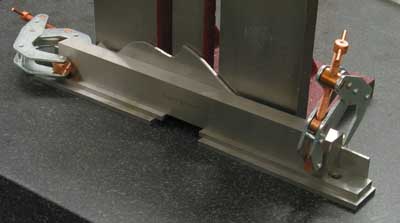
|
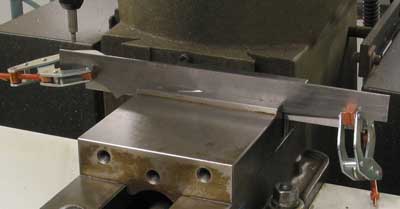
|
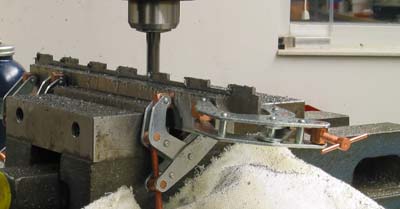
|
Holding the sides for milling the upper profile provides similar challenges. The next three photos show how I set up the left side for cutting the profile and chamfers. (Rough-cut the profile first using a bandsaw or jigsaw.)
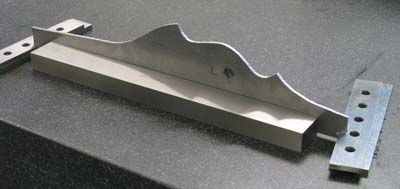
|
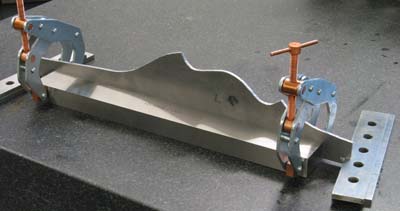
|
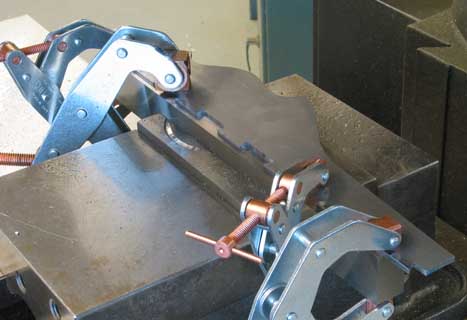
|
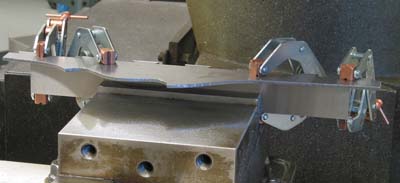
|
I used a hacksaw, drill press, jeweler's saw and files to make the iron from O1 tool steel, then heat-treated it with an oxy-acetylene torch, quenched in oil, then tempered with the torch again.
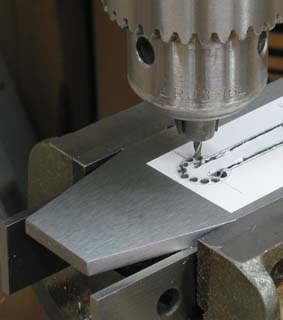
|
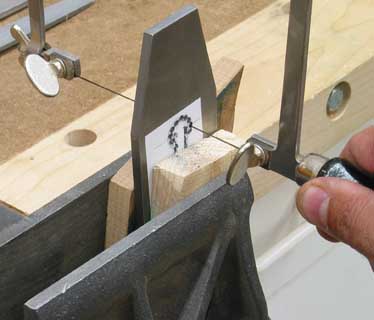
|